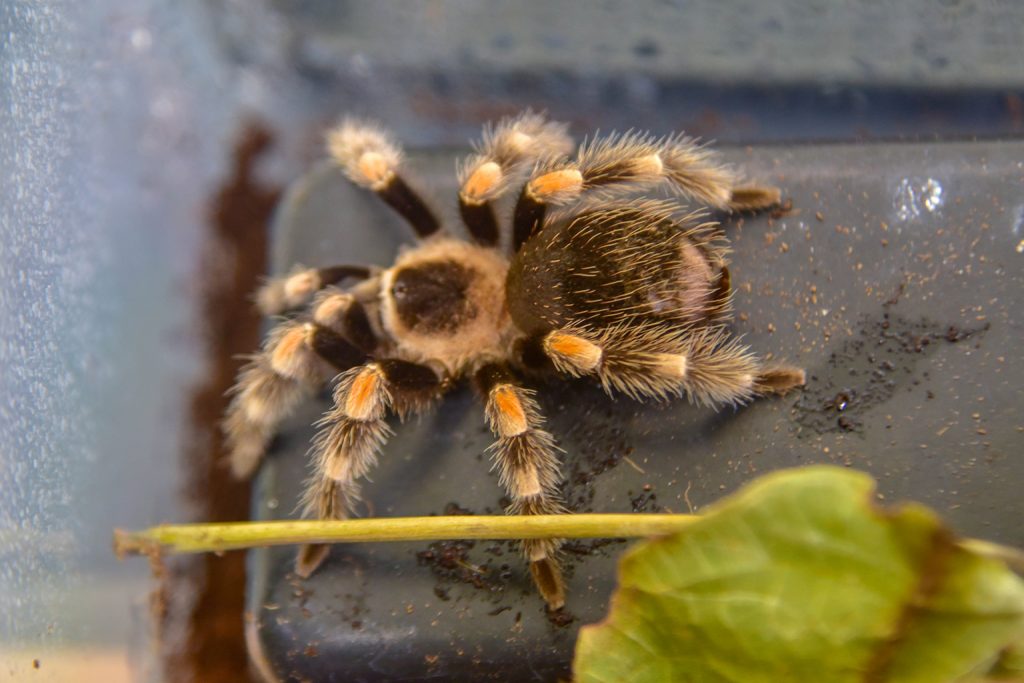Overview
“Where I live”
Mexican redknee tarantulas live in the tropical deciduous forests, dry forests, and deserts of, you guessed it, Mexico.
The Zoo has one tarantula in its Animal Embassy collection. Animal Ambassadors from this collection are introduced to audiences in education programs on and off grounds.
“How I live there”
Mexican redknee tarantulas hide during the heat of the day in their silk-lined burrows, which are located under thorny vegetation such as cacti. Once darkness descends, their burrows transform into the perfect location to ambush unsuspecting prey such as insects, frog, lizards, and mice. The burrow’s camouflaged silk welcome mat transmits the vibrations of passing prey to the tarantula so that it knows when to rush out and grab its next meal. After delivering a venomous bite, which paralyzes and liquefies the victim, the tarantula can then suck up the juices through its straw-like mouthparts. No need to fear for your own safety though, because while a Mexican redknee tarantula’s venom is fatal to its small prey, it’s only the equivalent of a bee sting to humans.
Biting also isn’t a tarantula’s first line of defense. When threatened, tarantulas will rear up to display their fangs or flick the barbed hairs off their abdomen. These “urticating” hairs can penetrate the skin of the attacker and cause painful irritation, and if they enter the eye they can cause blindness. Speaking of eyes, despite having 8 of them, tarantulas have poor vision. Instead they rely on the ends of their legs to detect vibrations, smells, and tastes to help locate prey and other tarantulas. Each of their 8 legs is also equipped with 2 claws that help them scale a variety of surfaces with ease.
“Making my mark”
Tarantulas have a unique claim to fame in that they were named after a high-energy Italian dance called the tarantella, in which the frenzied movements involved were thought to be the result of, or a cure for, the bite of a spider. Ironically, tarantulas are neither hyperactive nor are they spiders! While these slow-paced arachnids don’t have the same orientation of mouthparts required to be in the exclusive spider club, they still share many things in common with their spider relatives, from their signature 8-legged profile to their impact on the ecosystem. Tarantulas help to regulate insect and other small prey populations while acting as a food source for other predators.
Raising Young
Mating occurs in the summer during the rainy season, though the male doesn’t stick around for long. The real work is left to the female, who waits until spring to deposit 200-400 eggs into a silk egg sac. She then carries, cares for, and protects her offspring until they’re ready to become independent. This process may take a while though, since the eggs hatch after 3 months but the tiny freeloaders, also known as spiderlings, don’t leave the egg sac for another 3 weeks! Give it another 2 weeks though, and then the spiderlings are finally ready to disperse from their mother’s burrow. Despite being able to care for themselves at this point, they won’t be considered mature adults until they are 4-7 years old.
“What eats me”
Many animals that eat insects are also able to prey upon the Mexican redknee tarantula, especially birds and lizards, but the most notable nemesis of the tarantula is the Pepsis wasp. Also known as the tarantula hawk, this wasp parasitizes the unfortunate arachnids, using them as a living nest in which to raise their young. The female wasp lures the tarantula out of its burrow by disturbing the entrance’s concealed webbing, then stings the tarantula to paralyze it and injects a single egg in its abdomen. The wasp then seals the eight-legged incubator in a burrow and when the egg hatches it has plenty of food to complete its life cycle and emerges as an adult.
Conservation
Mexican redknee tarantulas are listed as Near Threatened by the IUCN, the world’s leading conservation organization. They were historically captured in the thousands for the pet trade. Currently, they are listed on CITES Appendix II, meaning that special permits are now required to collect them, yet the total population is still declining, and this is still due in part to over-collection. Another more pressing threat facing tarantulas is habitat loss due to urbanization, agriculture, and climate change. Not only is tarantula habitat shrinking or degrading as humans continue to develop the landscape, the changing conditions of the planet are resulting in more extreme weather patterns that lead to events such as extensive flooding, which influence habitat suitability.
Taxonomy
- Kingdom: Animalia
- Phylum: Chordata
- Subphylum: Vertebrata
- Class: Insecta
- Genera: Brachypelma
- Species: smithi

